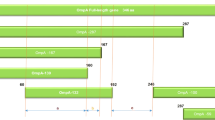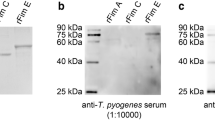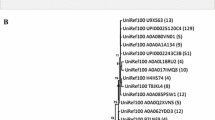Abstract
Several strategies and methods have been attempted to purify K99 fimbriae from enterotoxigenic Escherichia coli strains. Most of these methods are technically complex and time consuming. In current study a single-step ion-exchange chromatography method that takes just a few hours for purification of this important virulence factor was developed. K99 fimbriae were stripped from E. coli B41 strain by heat treatment and phosphate–urea buffer. The crude extracts were then equilibrated with Tris buffer and were loaded to a HiTrap SP XL column. By stepwise elevation of sodium chloride concentration, the FanC was eluted as a single species. The purified protein had high activity with anti-K99 monoclonal antibody in ELISA. Also, preincubation of red blood cells with the purified protein blocked adhesion of B41 bacteria. LPS contamination of purified FanC was in acceptable range using limulus amebocyte lysate method. In summary, this simple, inexpensive method yields purified FanC that has good purity, stability, and biological activity, making it suitable for many purposes including vaccination.




Similar content being viewed by others
References
Acres SD, Isaacson RE, Babiuk LA, Kapitany RA (1979) Immunization of calves against enterotoxigenic colibacillosis by vaccinating dams with purified K99 antigen and whole cell bacterins. Infect Immun 25(1):121–126
Altmann K, Pyliotis NA, Mukkur TK (1982) A new method for the extraction and purification of K99 pili from enterotoxigenic Escherichia coli and their characterization. Biochem J 201(3):505–513
Altmann K, Pyliotis NA, Wetherall JD, Mukkur TK (1983) A chromatographic method for the purification of K99 pili from enterotoxigenic Escherichia coli. J Gen Microbiol 129(Pt 6):1975–1982
Bakker D, Willemsen PT, Simons LH, van Zijderveld FG, de Graaf FK (1992a) Characterization of the antigenic and adhesive properties of FaeG, the major subunit of K88 fimbriae. Mol Microbiol 6(2):247–255
Bakker D, Willemsen PT, Willems RH, Huisman TT, Mooi FR, Oudega B, Stegehuis F, de Graaf FK (1992b) Identification of minor fimbrial subunits involved in biosynthesis of K88 fimbriae. J Bacteriol 174(20):6350–6358
Brinton CC Jr (1965) The structure, function, synthesis and genetic control of bacterial pili and a molecular model for DNA and RNA transport in gram negative bacteria. Trans N Y Acad Sci 27(8):1003–1054
de Graaf FK, Wientjes FB, Klaasen-Boor P (1980) Production of K99 antigen by enterotoxigenic Escherichia coli strains of antigen groups o8, o9, o20, and o101 grown at different conditions. Infect Immun 27(1):216–221
de Graaf FK, Klemm P, Gaastra W (1981) Purification, characterization, and partial covalent structure of Escherichia coli adhesive antigen K99. Infect Immun 33(3):877–883
de Graaf FK, Krenn BE, Klaasen P (1984) Organization and expression of genes involved in the biosynthesis of K99 fimbriae. Infect Immun 43(2):508–514
Gaastra W, de Graaf FK (1982) Host-specific fimbrial adhesins of noninvasive enterotoxigenic Escherichia coli strains. Microbiol Rev 46(2):129–161
Garg R, Tolbert M, Oakes JL, Clemente TE, Bost KL, Piller KJ (2007) Chloroplast targeting of FanC, the major antigenic subunit of Escherichia coli K99 fimbriae, in transgenic soybean. Plant Cell Rep 26(7):1011–1023
Guinee PA, Jansen WH, Agterberg CM (1976) Detection of the K99 antigen by means of agglutination and immunoelectrophoresis in Escherichia coli isolates from calves and its correlation with entertoxigenicity. Infect Immun 13(5):1369–1377
Hadad JJ, Gyles CL (1982) Scanning and transmission electron microscopic study of the small intestine of colostrum-fed calves infected with selected strains of Escherichia coli. Am J Vet Res 43(1):41–49
Isaacson RE (1977) K99 surface antigen of Escherichia coli: purification and partial characterization. Infect Immun 15(1):272–279
Isaacson RE, Start GL (1992) Analysis of K99 plasmids from enterotoxigenic Escherichia coli. FEMS Microbiol Lett 69(2):141–146
Jacobs A, Simons B, de Graaf F (1987) The role of lysine-132 and arginine-136 in the receptor-binding domain of the K99 fibrillar subunit. EMBO J 6(6):1805–1808
Jay CM, Bhaskaran S, Rathore KS, Waghela SD (2004) Enterotoxigenic K99+ Escherichia coli attachment to host cell receptors inhibited by recombinant pili protein. Vet Microbiol 101(3):153–160
Karkhanis YD, Bhogal BS (1986) A single-step isolation of K99 pili from B-44 strain of Escherichia coli. Anal Biochem 155(1):51–55
Kuzuya M, Yokoyama H, Kodama Y (1988) Purification of K88 and K99 pili from porcine enterotoxigenic Escherichia coli by affinity chromatography. Nippon Juigaku Zasshi 50(4):951–953
Lee JH, Isaacson RE (1995) Expression of the gene cluster associated with the Escherichia coli pilus adhesin K99. Infect Immun 63(10):4143–4149
Lintermans PF, Pohl P, Bertels A, Charlier G, Vandekerckhove J, Van Damme J, Schoup J, Schlicker C, Korhonen T, De Greve H et al (1988) Characterization and purification of the F17 adhesin on the surface of bovine enteropathogenic and septicemic Escherichia coli. Am J Vet Res 49(11):1794–1799
Morgan RL, Isaacson RE, Moon HW, Brinton CC, To CC (1978) Immunization of suckling pigs against enterotoxigenic Escherichia coli-induced diarrheal disease by vaccinating dams with purified 987 or K99 pili: protection correlates with pilus homology of vaccine and challenge. Infect Immun 22(3):771–777
Nagy B (1980) Vaccination of cows with a K99 extract to protect newborn calves against experimental enterotoxic colibacillosis. Infect Immun 27(1):21–24
Nagy B, Fekete PZ (1999) Enterotoxigenic Escherichia coli (ETEC) in farm animals. Vet Res 30(2–3):259–284
Ogunniyi AD, Kotlarski I, Morona R, Manning PA (2002) Epitope analysis of the FanC subunit protein of the K99 (F5) fimbriae of enterotoxigenic Escherichia coli using a recombinant fusion technique. FEMS Immunol Med Microbiol 34(1):23–31
Orskov I, Orskov F, Smith HW, Sojka WJ (1975) The establishment of K99, a thermolabile, transmissible Escherichia coli K antigen, previously called “Kco”, possessed by calf and lamb enteropathogenic strains. Acta Pathol Microbiol Scand B 83(1):31–36
Pilipcinec E, Huisman TT, Willemsen PT, Appelmelk BJ, de Graaf FK, Oudega B (1994) Identification by Tn10 transposon mutagenesis of host factors involved in the biosynthesis of K99 fimbriae of Escherichia coli: effect of LPS core mutations. FEMS Microbiol Lett 123(1–2):201–206
Roosendaal E, Boots M, de Graaf FK (1987) Two novel genes, fanA and fanB, involved in the biogenesis of K99 fimbriae. Nucleic Acids Res 15(15):5973–5984
Simons BL, Willemsen PT, Bakker D, Roosendaal B, De Graaf FK, Oudega B (1990) Structure, localization and function of FanF, a minor component of K99 fibrillae of enterotoxigenic Escherichia coli. Mol Microbiol 4(12):2041–2050
Simons LH, Willemsen PT, Bakker D, de Graaf FK, Oudega B (1991) Localization and function of FanH and FanG, minor components of K99 fimbriae of enterotoxigenic Escherichia coli. Microb Pathog 11(5):325–336
van Embden JD, de Graaf FK, Schouls LM, Teppema JS (1980) Cloning and expression of a deoxyribonucleic acid fragment that encodes for the adhesive antigen K99. Infect Immun 29(3):1125–1133
Vazquez F, Gonzalez EA, Garabal JI, Blanco J (1996) Fimbriae extracts from enterotoxigenic Escherichia coli strains of bovine and porcine origin with K99 and/or F41 antigens. Vet Microbiol 48(3–4):231–241
Wei CH, Liu JK, Hou XL, Yu LY, Lee JS, Kim CJ (2009) Immunogenicity and protective efficacy of orally or intranasally administered recombinant Lactobacillus casei expressing ETEC K99. Vaccine 28(24):4113–4118
Willemsen PT, de Graaf FK (1993) Multivalent binding of K99 fimbriae to the N-glycolyl-GM3 ganglioside receptor. Infect Immun 61(10):4518–4522
Yoshimatsu K, Yuyama Y, Ono E, Syuto B, Naiki M (1991) New methods for isolation of K99 fimbriae from enterotoxigenic Escherichia coli. J Vet Med Sci 53(6):1119–1121
Author information
Authors and Affiliations
Corresponding author
Rights and permissions
About this article
Cite this article
Golchin, M., Mohammadi, F. A new method for the rapid purification of FanC, the major subunit of K99. Comp Clin Pathol 21, 1317–1322 (2012). https://doi.org/10.1007/s00580-011-1289-1
Received:
Accepted:
Published:
Issue Date:
DOI: https://doi.org/10.1007/s00580-011-1289-1




